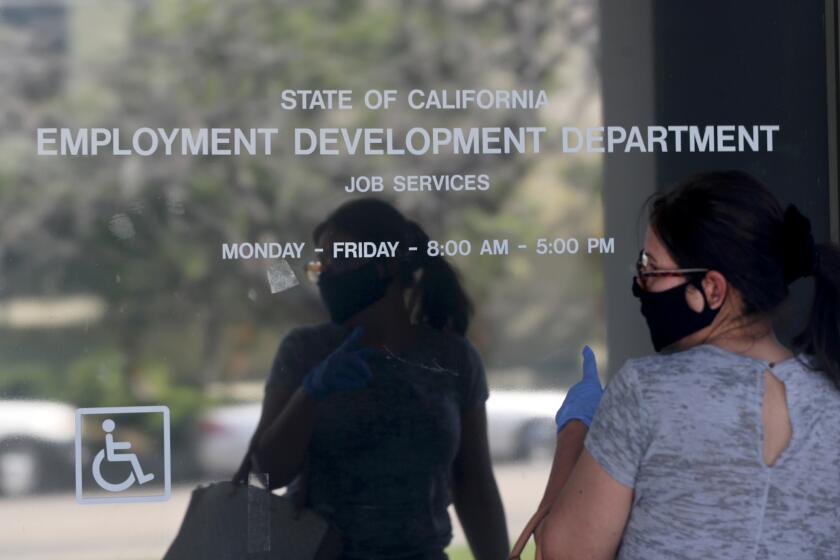Coronavirus forces sharp cuts to schools, healthcare in California, Newsom says

SACRAMENTO — With California’s economy hobbled by the impacts of the long coronavirus shutdown, Gov. Gavin Newsom asked state lawmakers Thursday to sharply curtail spending on public schools and an array of government services while directly appealing to President Trump and Congress for help to prevent billions of dollars in additional spending cuts.
“The federal government has a moral and ethical and economic obligation to help support the states,” Newsom said. “After all, what is the point of government, if not to protect people, our safety and the wellbeing of citizens?”
Absent that additional help, far beyond what California has already received in pandemic assistance, the governor said state officials have few options in the face of a projected $54.3-billion deficit through early next summer. The cuts envisioned recall many of those made during the depths of the Great Recession more than a decade ago.
Taking such measures, Newsom warned in his plea for federal help, could turn a fast-moving pandemic into a protracted crisis for California.
“If we’re serious about economic growth and getting this nation open again, then we must be serious about getting states and cities off the mat and back up so that we are moving,” he said.
The $203.3-billion government blueprint — $19 billion less spending than in the governor’s January proposal — is a stark reminder of how much has changed in the eight weeks since Newsom issued a statewide stay-at-home order to slow the rapid increase in COVID-19 infections. Analysts from the California Department of Finance project a $9.7-billion drop in tax revenues for the fiscal year that ends in June, with three times that amount expected to be lost in the 2020-21 budget year.
As California’s coronavirus case count approaches 75,000, 20 counties have met conditions to reopen more fully, the state said.
All told, 75% of the state’s budget deficit is attributed to a collapse in state tax revenues. The rest is roughly split between the cost of state and local coronavirus response and the rising number of Californians who, with reduced or no employment, are signing up for health and social services programs.
Newsom’s budget plan leans heavily on the idea that California’s fate rests on what happens in Washington. If additional federal dollars arrive in the next few weeks, it could erase as much as 40% of California’s deficit. But if the money doesn’t come through, the governor’s proposal envisions 40% of the solution to come from reduced spending. In both scenarios, the remainder of the deficit would be erased by cash reserves, existing government cash borrowed from internal accounts and new revenues collected by canceling tax breaks or imposing limited new fees.
The state’s $16.2 billion “rainy day” reserve fund, the centerpiece of efforts to fortify California’s budget resilience, would be emptied by the mid-summer of 2023.
“We are committed, despite the headwinds” of an economic downturn, Newsom said, “to balance the budget, but also to balance our principles and to advance our values.”
No budget-balancing idea proposed on Thursday may be more sweeping in its impact to California families than the $13.5-billion drop in projected spending on K-12 schools and community colleges, the largest line item in California’s general fund and one tightly bound to the rise and fall in tax revenues.
Newsom’s budget proposes filling in about $5.5 billion of that hole with one-time assistance, most of it coming from coronavirus funds provided by the federal government in March. But much of the rest in the new school year would come from cuts: less money for efforts aimed at addressing the needs of schoolchildren from low-income families and those who are English learners, less money for almost every school program — protecting only funds earmarked for special education.
In short, California Teachers Assn. President E. Toby Boyd said, the proposal is as bad as it gets.
“More than $10 billion in proposed cuts will lead to cuts to vital student programs, educator layoffs, furlough days and pay cuts just like it did during the last recession when we lost 33,000 educators,” Boyd said in a statement. “Our students, our schools, our colleges, and our families cannot afford to go back.”
Higher education programs are also targeted for cuts. Ten-percent reductions in state funding for the University of California and California State University systems are included in the governor’s plan, while dozens of proposals Newsom made in January are being shelved.
As with California budget dilemmas of the past, administration officials chose scope over size when it came to most spending cuts — scores of proposed small reductions instead of wholesale eliminations.
In Medi-Cal, the state’s healthcare offering for low-income residents, the budget plan assumes 2 million more people will be enrolled in the program this summer because of the coronavirus. Newsom’s proposal accounts for higher overall Medi-Cal spending than projected earlier this year but focuses those dollars on basic care. Gone are plans for expanding Medi-Cal to all adults in the U.S. illegally, a proposal long sought by immigration advocates and Democratic lawmakers. Dental benefits and spending on hearing aids for some recipients would be cut. Recent increases in rates paid to doctors who take Medi-Cal patients would be abandoned. And efforts to provide mental health services for women who have recently given birth are expected to be scrapped.
Welfare assistance grants through the CalWorks program would remain intact, but spending on employment and childcare services for those receiving the benefits would no longer keep pace with the influx of new recipients. State workers would not be laid off under Newsom’s plan, but would be asked to cut their salaries by 10%. State agencies where employees have worked from home during the pandemic could embrace more remote workdays, allowing the state to lease less office space.
At a news conference Thursday to present a revised state budget for the fiscal year starting July 1, Newsom said the state will need $43.8 billion to cover unemployment claims fueled by the coronavirus crisis in the new year, a 650% increase over what was originally proposed.
Outside of traditional government services, Newsom said he wants the Legislature to focus on addressing the coronavirus crisis, preparing for wildfire season and making progress toward helping California’s homeless population. His budget plan envisions a unique effort to address homelessness: the purchase by the state of hotels and motels, partially with federal funds, and then gifting those buildings to local governments as permanent supportive housing. Republican San Diego Mayor Kevin Faulconer has advocated for a similar idea, arguing the owners of local properties that have become vacant during the economic downturn might have an incentive to sell their facilities.
But that proposal — which would be separate from the existing coronavirus lodging plan — would not provide funding for the counties to operate the facilities.
The timing for what happens next in California’s budget process is unclear. Newsom’s budget director, Keely Martin Bosler, said Thursday that $14 billion in spending cuts can be avoided only if a new federal coronavirus relief plan is enacted prior to July 1, the beginning of the state’s fiscal year.
And even then, the size of the state’s economic problem is, at best, an educated guess. Californians who normally file and pay taxes in April were given a 90-day extension until July 15, thus leaving fiscal analysts to offer their best predictions on how much there will be to spend.
Legislators will also have less information on which to base their discussions of Newsom’s plan. Both the state Senate and Assembly adjourned in March due to public health concerns and have not held their traditional public hearings examining dozens of state programs. They will now have to speed through a basic review of those needs in the next few weeks in order to meet their constitutional deadline of June 15 for sending a final budget to the governor’s desk.
Times staff writer Phil Willon contributed to this report.
More to Read
Sign up for Essential California
The most important California stories and recommendations in your inbox every morning.
You may occasionally receive promotional content from the Los Angeles Times.













